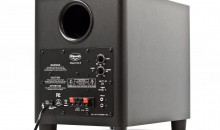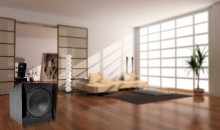Speaker Cabinet Design – Styles and Techniques
I have a friend who “loves his speakers”. He should, he designed them himself. It’s not something I would recommend to just anybody. My friend is an engineer by trade, and a person with an uncanny ability to focus and delve deeply into the principles behind the area of loudspeaker design. There were a ton of speaker cabinet design directions he could have gone with, but he settled on some very simple plans that allowed him to do some comprehensive math and acoustic calculations using software made for that very purpose.
Speaker Cabinet Design Basics
The first thing to decide before choosing a speaker cabinet design is what frequency range you’re going to achieve (or attempt). The frequency range–particularly the low frequency extension, will guide some basic dimensions related to the speaker cabinet design. H-PAS and other fancy porting solutions aside, the capabilities of the low frequency driver will ultimately interact with the speaker cabinet and affect your low frequency response and tuning.
There’s also the question of aesthetics. Do you want a floorstanding tower speaker, or a pair of bookshelves? Are you designing a full-range speaker or a subwoofer? I have yet to see any of my friends tackle a bipole or dipole speaker–and for good reason. Those are highly advanced designs that incur their own set of difficulties and design challenges.
Example: I want to go with a tower design that is ported.
Speaker Cabinet Shape Considerations
There are some very basic principles involved in calculating standing waves and the effects of a speaker on the enclosure (and vice versa) when you deal with a “perfect” cuboid shape. Get into a rhombus, however, and now you’re going to need more sophisticated software to understand what might be happening inside the cabinet and how that will affect your speakers.
After understanding the basic shape you want to start with, and whether you’ll want to do manual or computer-calculated designing (we recommend using a computer and then checking your work with plenty of listening tests), you then have to determine what other characteristics your speaker will have. Will the box be ported (also called a bass-reflex design)? Where will that port exist (front or back)? Will you opt for an acoustic suspension design (also called a sealed design)? Each of these considerations needs to take place before proceeding too far down the path of loudspeaker design. We’ll get into the software considerations later in this article. For now, just know that you have some preliminary decisions to make before going too far.
Example: I want a trapezoidal top on a ported cuboid base.
Crossover Design – Passive, Active, or a Kit
A crossover is a typical component in any loudspeaker design, though I have heard of designers custom-making speakers without the use of a crossover. In most cases, however, a crossover is needed to filter what frequencies go to the tweeter or high frequency driver and which go to the low frequency driver. Before you’ll be able to continue with your speaker design, you’ll need to understand whether or not your design will be active or passive. Chances are that you’ll be using an existing kit if you go with an active design since they are so difficult to design. Some, however, may opt to roll their own passive crossover network–perhaps based on a computer recommendation or an existing kit design. It all depends on how far you want to take or customize your loudspeaker design. Here is a great Excel-based application/file that can help you if you are interested in designing and building your own crossover.
Example: I’m going to use a passive crossover kit that should do what I need.
Speaker Cabinet Design Software
The next thing you’re going to inevitably want to investigate is speaker cabinet design software. While you can certainly design a box, do your own math, and add your own drivers, investing in a good piece of speaker design software will do wonders. We can’t list every piece of software here, but these are just some of the more popular ones, or ones we’ve been acquainted with in the past:
AJ Designer – AJ Designer speaker design software has the ability to help with bandpass, vented, and sealed subwoofer designs. The software provides an easy to use interface to calculate volumes of the front and rear chambers of the box, calculate box dimensions, determine the resonance frequency, -3 dB points for both the high and low pass filters, port length and diameter, frequency response plot, and power response.
Unibox – Unibox is more of a sophisticated spreadsheet than a piece of software. It operates under the principle that simplifcation is no longer needed and the full driver-box model can be implemented. The full driver-box model includes individual control of absorption, leakage and port losses. The software also includes graphs for sound pressure levels produced by port leaks, speaker impedance and step response. Unibox works for
Boxnotes – Boxnotes is software designed to help you design a subwoofer with appropriate dimensions for the goals you have. It accounts for extra volume taken up by your ports, bracing and driver; checks the minimum dimensions required to house your driver; lets you see the effect of changing port parameters; and helps you spot problem resonances and adjust your dimensions. It even prints your cutting list.
Winspeakerz – Winspeakerz lets you select a woofer for your home theater speaker from the driver database and load it into the software. You then select the type of enclosure you want to simulate (closed, vented or bandpass with a total of 18 different variations). You can then enter different volumes and tunings and run the analysis to analyze the effects. After deciding on the box you can then open the box calculator and have WinSpeakerz suggest your loudspeaker dimensions.
There are a ton more applications, some commercial (SoundEasy, Eminence Designer, etc) and some freeware or trialware (like this woofer box and circuit designer). If we didn’t include your favorite here, please leave a comment below, and we’ll get it added to the list.







Please let me know tower speaker box measures I want to build 2 woofer and 1,teeeter150w per channel 6 ohms or 8ohms
Thanks Clint for this well written informative article. Do you have or know of any information available covering the internal design of speakers; e.g. baffles, ports (horns), packing materials, etc. I may be using the wrong terminology so please excuse my lack of knowledge. Thanks
That’s a HUGE topic, and not one that I’d likely be able to answer or address in the comments section of this post.
Clint, I am wanting to build a bluetooth speaker out of a pair of 4″ Pioneer coaxial speakers. I can not find any designs for a single box that would support mounting both speakers. The bluetooth amp supports stereo out. How do I separate the two sides so that they don’t interfere with each other? Looking to build as small a box as possible. I am having difficulty finding bluetooth box designs.